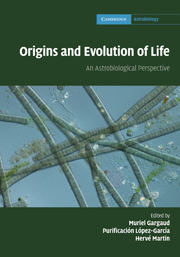Book contents
- Frontmatter
- Contents
- List of contributors
- Foreword
- Preface
- Part I What is life?
- Part II Astronomical and geophysical context of the emergence of life
- Part III The role of water in the emergence of life
- Part IV From non-living systems to life
- Part V Mechanisms for life evolution
- Part VI Life in extreme conditions
- Part VII Traces of life and biosignatures
- 25 Early life: nature, distribution and evolution
- 26 Early eukaryotes in Precambrian oceans
- 27 Biomineralization mechanisms
- 28 Limits of life and the biosphere: lessons from the detection of microorganisms in the deep sea and deep subsurface of the Earth
- Part VIII Life elsewhere?
- Index
26 - Early eukaryotes in Precambrian oceans
from Part VII - Traces of life and biosignatures
Published online by Cambridge University Press: 04 February 2011
- Frontmatter
- Contents
- List of contributors
- Foreword
- Preface
- Part I What is life?
- Part II Astronomical and geophysical context of the emergence of life
- Part III The role of water in the emergence of life
- Part IV From non-living systems to life
- Part V Mechanisms for life evolution
- Part VI Life in extreme conditions
- Part VII Traces of life and biosignatures
- 25 Early life: nature, distribution and evolution
- 26 Early eukaryotes in Precambrian oceans
- 27 Biomineralization mechanisms
- 28 Limits of life and the biosphere: lessons from the detection of microorganisms in the deep sea and deep subsurface of the Earth
- Part VIII Life elsewhere?
- Index
Summary
Origin and diversity of eukaryotes
Origin
Life on Earth is classed into three phylogenetic domains: the Archaea, the Bacteria and the Eucarya. Eukaryotic cells are less diverse than prokaryotes metabolically, but have a complex cellular architecture comprising a nucleus, a cytoskeleton (a proteinic network structuring the cytoplasm to facilitate intracellular traffic, endo- and exo-cytosis and amoeboid locomotion; Cavalier-Smith, 2002), an endomembrane system (a system of internal membranes subdivided into several organelles, and used for synthesis, processing, packaging and transport of macromolecules such as lipids and proteins) and organelles such as mitochondria (or derived organelles) and chloroplasts in photosynthetic eukaryotes. Archaea and Bacteria are called prokaryotes because their cells do not contain a nucleus or organelles, and because transcription and translation are coupled, i.e. they do not occur in different cellular compartments. The prokaryotes have diverse and complex metabolisms, but simpler cellular architecture. They possess proteins playing the role of cytoskeleton, but not the motor proteins involved in intracellular transport as in eukaryotes (Moller-Jensen and Lowe, 2005; Cabeen and Jacobs-Wagner, 2005) and some (the planctomycetales) may possess endomembrane systems (e.g. Fuerst, 2005).
The eukaryotic genome is seen as a mosaic of bacterial genes (involved in energy and carbon metabolism) and archaeal genes (related to DNA replication, transcription and translation), but it also contains a core set of genes and proteins unique to eukaryotes (e.g. Kurland et al., 2006), while the membrane lipids are closer to those of the bacteria (Rivera et al., 1998).
- Type
- Chapter
- Information
- Origins and Evolution of LifeAn Astrobiological Perspective, pp. 414 - 449Publisher: Cambridge University PressPrint publication year: 2011
- 29
- Cited by



